

© Shipping Wonders of the World 2012-

Signposts of the Sea
The Lighthouse, whether built on a lonely, wave-
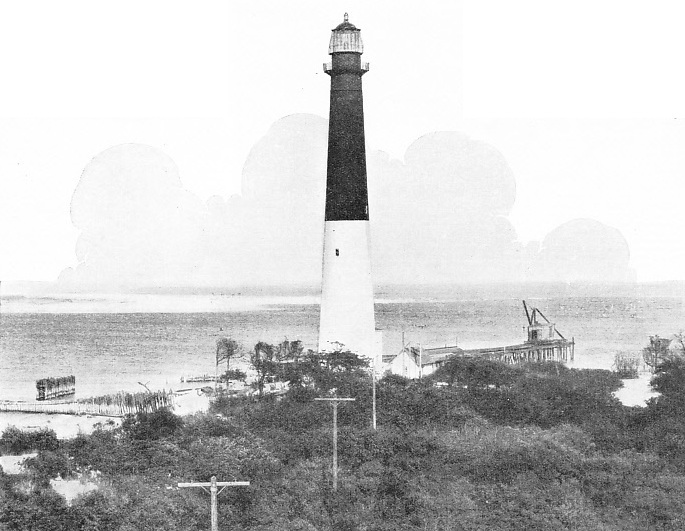
OFF THE COAST OF NEW JERSEY, Barnegat Lighthouse is on the Atlantic seaboard of the United States of America. It was near this lighthouse that the U.S. airship Akron was wrecked in 1933.
IN daylight the contours of a far-
At sunset each lighthouse must send out to sea a distinctive beam. No towering landmark is more eagerly looked for than the up-
Wireless telegraphy development has enabled modern ships to establish their positions when approaching land by means of wireless signals and direction-
Landfall lighthouses, always of the latest design, have the widest ranges. Coastal and warning lights serve a different purpose. They are designed chiefly so that each one can be quickly and easily distinguished from its neighbour. Harbour lights are of a third type.
Lighthouses not only signal to ships by light and sound; some are also watch-
Trinity House -
Lighthouses are costly to build and to maintain. The most expensive and difficult to build are those erected on wave-
In lighthouses standing on isolated rocks the prime essential is strength, and granite is the stone preferred if it can be obtained. Sometimes the tower outlasts the rock on which it is built. This has been so with the Eddystone and the Fastnet. The action of the waves undermined the rock on which the third Eddystone tower was erected, so the fourth was erected some distance from it. Part of the third tower is still in existence.
The original Fastnet Lighthouse was a cast iron cylinder. It was built on a pinnacle rising about 100 feet above low water. Despite this height the waves sometimes shot up the sheer face of the cliff and shook the tower. Huge seas pounded pieces out of the rock until the tower was undermined. A new masonry tower was built on a ledge below high-
It may seem strange that it is sometimes preferable to put a light close to the water instead of high above it on top of a cliff. In a clear atmosphere the higher the light the better, but practice has proved the danger of this in a climate such as that, for example, of Great Britain. The original lighthouse at Beachy Head in Sussex was built on top of the cliffs to the west of the present rock lighthouse, and was often obscured by fog that did not exist nearer sea-
To erect this light on a site covered at high water, a circular cofferdam was built first. This was pumped dry of water when the tide ebbed, and so lengthened the time available for the workmen to bring the base above high-
Materials were lowered from the top of Beachy Head by a cable-
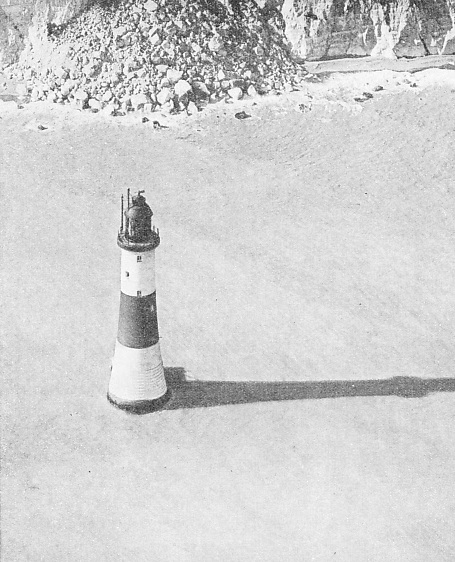
AERIAL VIEW of Beachy Head Lighthouse, off the Sussex Coast. Where fogs are common, it has sometimes been found better to place a lighthouse close to the water instead of on the top of a cliff. The original lighthouse at Beachy Head, built on top of the promontory, was often obscured by fog that did not exist nearer sea-
The usual method of constructing a stone lighthouse on a wave-
Even more exacting is the transit of the lantern apparatus. When this has been successfully landed on the rock, there remains the danger that a sudden gale may spring up and damage the parts of the apparatus before they are assembled in the security of the tower. The workmen have to be isolated for long spells, and quarters have to be erected so that they can live on the rock. The early stages of the work can only be done in fine weather.
A famous light is the Bishop Rock Lighthouse, which, with those of Ushant and the Lizard, is one of the landfall lights for ships entering the English Channel. It guards the Scilly Isles. Situated in one of the most storm-
The cylindrical shape of the base of these rock lighthouses takes the blows of the waves at the strongest part of the tower, and breaks them so that only spray rises to the level of the lantern. This design is better than the former spreading base, which tended to throw the waves upwards, so that in storms they would strike the base of the lantern gallery with such force that the stones of the cornice were sometimes shifted.
Iron lighthouses on the screw-
A pioneer of this type was the Maplin Lighthouse which marked the Maplin Sands off the Essex coast of the Thames Estuary, but this structure collapsed a few years ago. Another of the same type is the Chapman Lighthouse in Sea Reach of the Thames, off Canvey Island. The legs are iron tubes having screw-
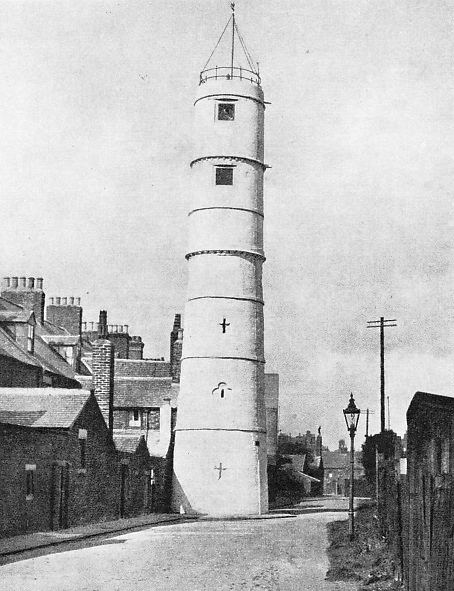 Such lighthouses are not suitable for exposed sites where the waves may rise high enough to subject the lantern to the danger of being swept away, owing to the resistance offered by the surface area, but they fulfil a useful purpose and are found in shoal waters, particularly off the Florida Coast of the U.S.A. Some lights are a compromise between a screw-
Such lighthouses are not suitable for exposed sites where the waves may rise high enough to subject the lantern to the danger of being swept away, owing to the resistance offered by the surface area, but they fulfil a useful purpose and are found in shoal waters, particularly off the Florida Coast of the U.S.A. Some lights are a compromise between a screw-
IN A STREET. The unusual position of a lighthouse at Blyth, Northumberland. Blyth is a coaling seaport about twelve miles north-
In some parts of the world the exposed nature of the coast makes it impracticable to erect a screw-
built the iron tower, the base of which was filled with concrete. A breastwork of brushwood mattresses and broken stone was built on the sand to prevent the tide from scouring the sand away.
The Fourteen Foot Bank Lighthouse which marks a shoal in Delaware Bay, U.S.A., is of the same type. During construction the caisson shocked the engineers by taking a list and they realized that the sandbank was not level. They managed, however, to right the caisson by weighting the higher side with concrete until the weight forced it level.
These lighthouses are near centres of civilization, where skilled labour and modern appliances are available. The problem of erecting lighthouses in places many miles from land is solved by building lighthouses of steel or iron plates, bolted together, erecting the lighthouse in the builder’s yard, and then dismantling it and shipping it to the site and re-
Important though the construction is, the light itself is more important. The lighthouse consists of the tower, the lens with its supporting pedestal, burner and accessories, and the projecting lantern. The lens, burner and accessories mark the modern development. It is upon this part of the lighthouse that scientists have concentrated, and a modern apparatus is the largest form of optical instrument in use.
The early lighthouses were stacks upon which fires of wood or coal were lighted, these being followed by candles that were protected by glass from being blown out. It was not until oil lamps were introduced that it was possible to consider some means of concentrating the light and reflecting it. Smeaton’s Eddystone Lighthouse, wonderful structure that it was, merely showed the light of twenty-
A modern hyper-
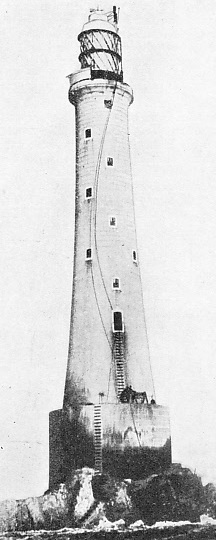 After the unaided light, which depended only upon the number of candles or the size of the fire, the first step forward was the use of silvered glass fitted together to form a paraboloid. This was followed by silvered metal reflectors. The third stage was the use of glass lenses and prisms to magnify the light from a single source at their centre. Augustin Fresnel, a Frenchman, invented the stepped lens, and this was developed by his successors. The scientist has perfected the lens with the object of making each light individually distinctive to the mariner. There are, however, many difficulties. The eye-
After the unaided light, which depended only upon the number of candles or the size of the fire, the first step forward was the use of silvered glass fitted together to form a paraboloid. This was followed by silvered metal reflectors. The third stage was the use of glass lenses and prisms to magnify the light from a single source at their centre. Augustin Fresnel, a Frenchman, invented the stepped lens, and this was developed by his successors. The scientist has perfected the lens with the object of making each light individually distinctive to the mariner. There are, however, many difficulties. The eye-
Lights are fixed or revolving. Fixed lights must be visible all round, and only the light lost above in the sky or below on the land must be bent down and up to go to the horizon. Revolving lights do not have to illuminate the full 360 degrees of the whole horizon at the same time, but only each point at intervals. The rays are condensed horizontally as well as vertically, and form solid beams or columns of light.
BISHOP ROCK LIGHTHOUSE, Scilly Islands, is one of the landfall lights for ships entering the English Channel from the west. The first structure, built on the screw-
The revolving lenses concentrate the light from the burner, and at intervals flash it round the horizon, and also down to the sea and up into the sky in a way that no solid fixed lens could do even if it were possible to manufacture one of sufficient size. A fixed light has a limited range, but a revolving light is more effective ; a mariner a long way out at sea does not see the light itself, but sees the reflection in the sky. The reason is that the curve of the earth is between the mariner and the lantern so that it is impossible for him to see the structure, but he can see its reflection.
If the fixed light were allowed to shine all round the horizon its identification would be difficult; thus the light is occulted, or cut off for a period by revolving a screen round the lamp or by lowering a cylinder over it. By altering the spacing of the screen different periods of eclipse can be arranged. Similarly with the revolving light, the arrangement of the flashes is determined by the position of the lenses.
At first all revolving lights showed single flashes, the lenses being evenly spaced, and then the group-
Most lighthouses have a landward sector where the light is not needed, and the light from this are can be used elsewhere, being reflected by glass prisms to a point where it is needed as a subsidiary light. A number of lighthouses have a subsidiary light that shows below the main light and marks some particular reef or shoal. The rays of light are reflected vertically down the tower and out horizontally through a window.
The classification of the lights is decided by the distance from the centre of the light to the inner surface of the lens, called the focal distance. The most powerful is the hyper-
The revolving parts weigh up to six tons, and the problem of turning them with the least possible effort has been solved by mounting the apparatus on a mercury float pedestal. Friction is so slight that the whole is revolved by means of clockwork.
For many years wick burners were used, but these have been superseded by electric lamps and mantle lamps burning vaporized oil. The nature of the illuminant depends upon the location of the lighthouse. The pioneer British lighthouse for electricity was the South Foreland, on the Kent coast. Now there are a number of electric lighthouses, but incandescent mantle burners using oil are better for isolated towers where it is not possible to lay electric cables from the shore and where it would not be convenient to install a plant for generating light. The electric lamps made for lighthouses are of high candle-
The Eddystone is a lighthouse with a subsidiary light. The main light is 133 feet above high water and is a white double-
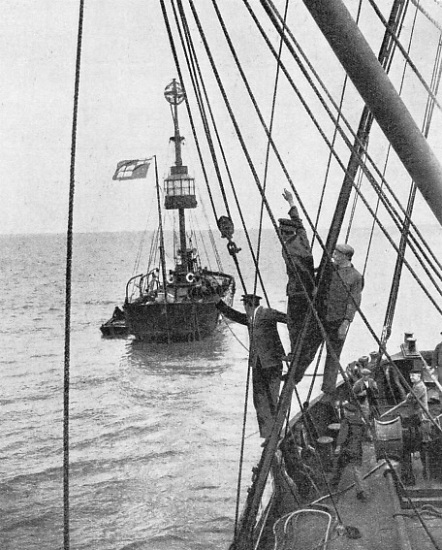
RELIEVING A LIGHTSHIP. The relief of the Breaksea, stationed in the Bristol Channel, off the Glamorganshire coast. The vessel is painted red, and has a ball at the masthead. It gives one white flash, with a light of If seconds every fifteen seconds, visible eleven miles. There are also a fog siren and a submarine bell.
The mariner is not likely to confuse this with the Lizard with its white light flashing every three seconds (flash one-
The above arrangements are those at the time of writing, but as they are liable to alteration, lights must be checked for nautical purposes by the lights lists and notices to mariners.
The timings of lights distinguish them. In daytime the lighthouse can be used by ships as a beacon to establish their distance off shore. The angle of its height above sea-
The improvements in lighting and mechanism have added to the responsibilities of the lighthouse keeper. Despite modern progress the rigours of duty in an isolated rock lighthouse are such that few men care to undertake them; keepers are still cut off from relief by prolonged storms.
The keepers of a rock lighthouse lead a more cramped existence than prisoners, as in some lighthouses the lantern gallery and the landing platform at the base of the tower are the only spaces available for exercise.
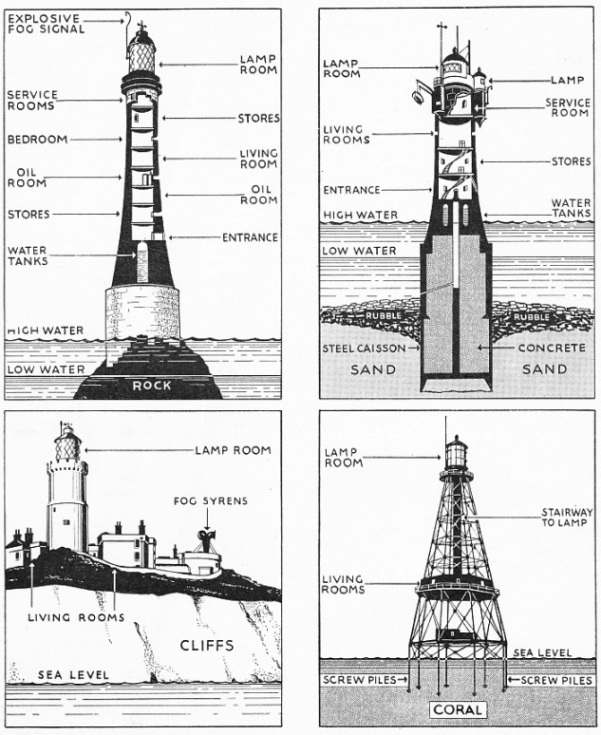
FOUR TYPES OF LIGHTHOUSE illustrated diagramatically. The top left picture shows one built on a wave-
The lamp is lighted at dusk and the clockwork is wound up. The light is watched and a look-
E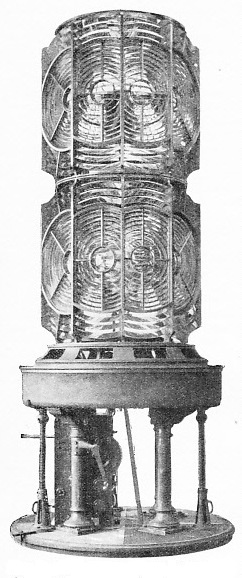 ven this scheme is not infallible. The Flannen Islands Lighthouse, fifteen miles off the Hebrides, was found deserted on Boxing Day, 1900. There was a staff of three keepers, but they had vanished. Examination of the logbook showed that the last entry had been made at 4 a.m. nearly a week previously; the lamp had burned itself out. It is thought that one man went on to the rock during a storm and was swept into the sea and that the other two perished when trying to save him.
ven this scheme is not infallible. The Flannen Islands Lighthouse, fifteen miles off the Hebrides, was found deserted on Boxing Day, 1900. There was a staff of three keepers, but they had vanished. Examination of the logbook showed that the last entry had been made at 4 a.m. nearly a week previously; the lamp had burned itself out. It is thought that one man went on to the rock during a storm and was swept into the sea and that the other two perished when trying to save him.
The most recent development is the unattended lighthouse, which is automatic. The Heugh Lighthouse, Hartlepool, is of this type and is electric, the light being switched off at sunrise and lighted at sunset by a patent valve. This valve consists of two glass bulbs, one black and the other clear, which are connected by a tube and are partly filled by liquid ether. When daylight arrives the black bulb becomes warmer than the clear one, and the pressure within it increases and causes the liquid to flow to the clear bulb, the extra weight tipping this down and causing the electric current to be cut off. When darkness approaches, the process is reversed and the liquid flows back to the black bulb, switching the current on. Power for the light is supplied by a cable, but if this should fail, a petrol generating-
THE 500 mm. (19·7-
Unattended lighthouses lighted by gas are operated by valves working on similar principles; a black rod used in conjunction with burnished rods expands and contracts according to the light, and opens or closes the gas valve. Such “lighthouses are left safely for months in certain parts of the world.
These automatic lighthouses, which are visited at certain intervals by officers of the lights service of the country concerned, have alleviated the hardships of tending lights on some exposed and isolated coasts, as they have no keepers who are marooned for long periods. But since the lighthouse is an outpost of civilization, the principal lighthouses on distant coasts continue to be garrisoned by men. The wilder the spot, the greater the need for a lighthouse to warn ships of the dangers of the shore in all conditions of weather. These dangers are augmented on some coasts by the savage nature of the natives, who regard a wreck as a gift from the sea-
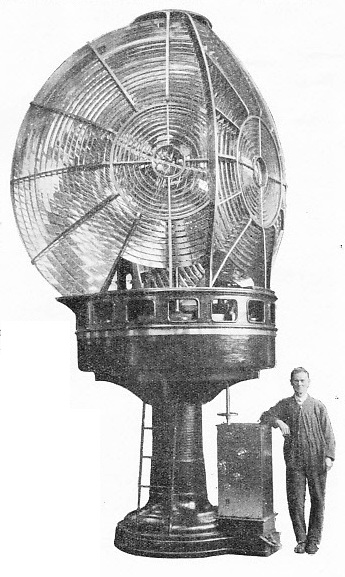 In a country such as China, which was opened up to Western civilization from the sea, the establishment of lighthouses and the building up of a service were essential. The work in China was undertaken by the Chinese Customs, under British supervision. The training of native keepers necessitates the instructors having deep knowledge of Chinese psychology. One Chinese lighthouse
In a country such as China, which was opened up to Western civilization from the sea, the establishment of lighthouses and the building up of a service were essential. The work in China was undertaken by the Chinese Customs, under British supervision. The training of native keepers necessitates the instructors having deep knowledge of Chinese psychology. One Chinese lighthouse
keeper complained that there was a devil in the lighthouse. He received little sympathy, but was told that, as no devil would annoy a good man, he was a bad man, and unless he reformed and the devil left him he would be discharged from the service. The devil promptly disappeared. Several Chinese lighthouses have been wrecked by earthquakes.
Lighthouse keepers in lonely places are sometimes called upon to help ships in distress. They cannot neglect the light, but they frequently go to the aid of vessels in a boat, send a message to a settlement, or feed and house shipwrecked sailors until relief arrives.
A 920 mm. (36·2-
The most dreaded enemy of the seaman in coastal waters is fog that blinds the lighthouse. Immediately fog descends the fog-
A modern type of fog signal called the diaphone is now in general use. It is operated by compressed air and has a deep and penetrating sound at the end of each blast. The note is always the same, and can be regulated either to give a distinctive blast for the station or to signal by Morse code. The instrument consists of a piston that has a short reciprocating motion parallel to its axis in a cylinder into which it fits closely. The piston and cylinder have narrow circumferential slits cut in them, and the sound is caused by compressed air passing through these slits as the motion of the piston brings them opposite each other. The complete plant consists of the diaphone and its horn, the timing mechanism for giving the character of the blasts, air compressors, the power unit to drive them, the air receivers and piping. The type of power unit depends on the lighthouse. In one isolated on a rock the engine burns the same oil as is supplied to the burners of the lantern.
I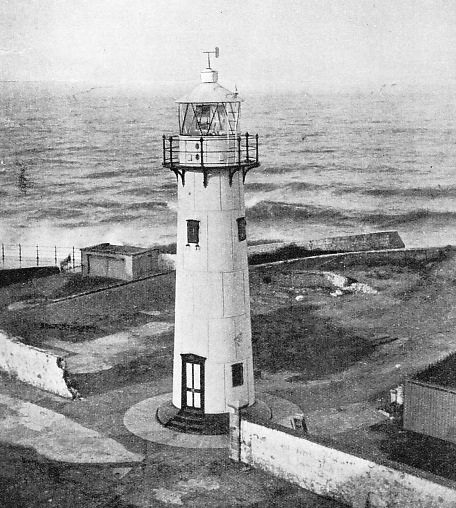 n distributing the sound, problems similar to those of distributing the light have been solved, and the resonator, or horn, varies in shape according to local requirements. If the sound is required to be distributed over a complete circle, the horn is vertical and is called a mushroom resonator.
n distributing the sound, problems similar to those of distributing the light have been solved, and the resonator, or horn, varies in shape according to local requirements. If the sound is required to be distributed over a complete circle, the horn is vertical and is called a mushroom resonator.
ON THE EAST COAST of England. Heugh Lighthouse, Hartlepool, Co. Durham, has one white flashing light, showing two flashes of one second each, with an interval of two seconds between them every ten seconds. It has a visibility of thirteen miles, and is automatic in action, the light being switched on and off, at sunset and sunrise, by a patent valve.
Follow this link to see illustrations from the Photogravure Supplement.
You can read more on “Buoys and Beacons”, “Day and Night Signals at Sea” and “Lightships” on this website.
You can read more about “Sentinels of the Sea” in Wonders of World Engineering